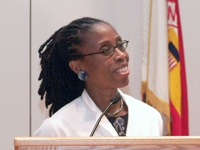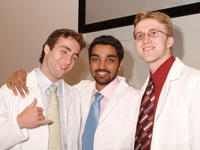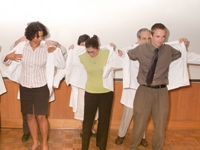101 Students Begin their Weill Cornell Careers with the White Coat

Dr. Carla Boutin-Foster stressed the importance of finding a mentor during a medical student's career.
Although stethoscopes are often seen adorning physicians, the white coat is the most easily recognizable symbol of the doctor. It immediately connotes altruism, compassion and excellence, and studies have shown that patients associate the coat with increased patient trust, increased confidence in their physician and an increase in the likeliness to disclose personal matters.
The 101 students of the Weill Cornell Class of 2010 donned their white coats for the first time on Tuesday, Aug. 22 in Uris Auditorium during the College's annual White Coat Ceremony and Opening Exercises, formally undertaking the values of the Hippocratic Oath as they embark on an education in the science and art of medicine.
In addition to an address by an eminent physician and a discussion of the oath, the presentation of white coats formally represents the belief by faculty physicians that the incoming class will carry on the humanistic traditions of doctoring.

MD-PhD students (from left) Maxime Kinet, Suchit Patel and Krzysztof Glomski.
"It is a significant article of clothing; it is a powerful symbol and one that should not be taken lightly. This is a milestone in your educational and professional life. The donning of a white coat confers a sense of authority," said Dr. Carla Boutin-Foster, the ceremony's keynote speaker and assistant professor of complementary and integrative medicine at Weill Cornell.
Dr. Antonio Gotto, dean of the Medical College, underscored the solemnity of the occasion with a reading of the Hippocratic Oath, which was rewritten last year by a Weill Cornell committee headed by Dr. Joseph Fins.
"In our profession there is an ancient custom that no one may be admitted to the field who has not first expressly accepted the values set forth in an oath. Although you'll not take this oath today until you complete your degree in 2010, it is important to begin your medical education by reflecting upon its meaning and import," Dr. Gotto said.
Dr. Charles Bardes, associate dean for admissions and professor of clinical medicine, formally began the presentation of the white coats by recalling the Medical College's founding philosophy.
"In its founding in 1865, Cornell University embodied two principles that were quite new at the time and these two principles were carried forward in the founding of the Medical College shortly thereafter," Dr. Bardes said. "The first was a progressive spirit in education that emphasized new scientific and humanistic disciplines rather than old classics and antiquated sciences. The second was unique dedication to inclusiveness and diversity."
The Weill Cornell Class of 2010 continues the dedication to these principles; of the 101 enrollees, 50 are women and 37 enter medical school with non-science degrees. Students range in age up to 45 and come from more than 50 undergraduate universities.

Class of 2010 students Danielle Acosta, Hanna Alemayehu and Byron Alex are helped into their white coats by faculty members.
The incoming students also participated in the Opening Exercises, a tradition in which a recently hired department chair is invited to speak to the students. The 2006 Opening Exercises speaker was Dr. Gerald Loughlin, the Nancy C. Paduano Professor of Pediatrics and pediatrician-in-chief at the Komansky Center for Children's Health, who was recently recruited from Johns Hopkins School of Medicine.
Dr. Loughlin praised the students' decision to pursue medicine. "It's your choice to be a doctor and to come to Weill Cornell—that tells us a tremendous amount about each one of you and about your families and your background," he said. "Being a Weill Cornell medical student is an achievement that will have lasting endurance and substance. Will you work? Yes, surely. Will it be stressful? Most assuredly. Will it be fun? No doubt about it, this is great fun. You will not regret joining this Weill Cornell Medical College tradition."
Photos by Weill Cornell Art & Photo.

